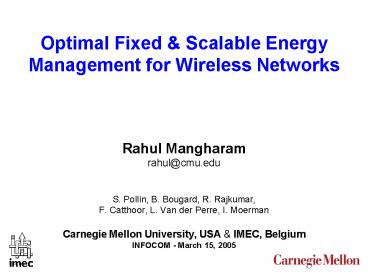Optimal Fixed PowerPoint PPT Presentation
1 / 26
Title: Optimal Fixed
1
Optimal Fixed Scalable Energy Management for
Wireless Networks
- Rahul Mangharam
- rahul_at_cmu.edu
- S. Pollin, B. Bougard, R. Rajkumar,
- F. Catthoor, L. Van der Perre, I. Moerman
- Carnegie Mellon University, USA IMEC, Belgium
- INFOCOM - March 15, 2005
2
The Device Energy Crisis
Source 1
- Processor Power Consumption 200/4 years
- Battery Energy Density 25/
4years
1 K. Lahiri, A. Raghunathan, S. Dey, D.
Panigrahi "Battery-Driven System Design A
New Frontier in Low Power Design", VLSI Design,
Jan. 2002
3
The Wireless Transceiver Energy Crisis
x 4.0hrs 4.0 Whr x 2.0hrs 2.6 Whr ?7.5Whr x
0.5hrs 0.9 Whr
- How long will a battery last today?
- Handhelds weight lt 350g. (12oz)
- Batteries
- Battery Weight lt 50 of handheld (175g)
- Capacity 90Whr/Kg (NiCd) ? 15Whr
- 802.11a Transceiver consumes 7.5Whr or 50
- Transceivers consume upwards of 30 of a
laptops overall energy
4
Outline
- The Cross-Layer Energy Management Problem
- MEERA Methodology for Energy Efficient Resource
Allocation - Theoretical Foundations
- Two-phase Solution Approach
- Design Time
- Run-Time
- System Case Study 802.11a Transceiver
- Energy Vs Performance Results
5
Focus on MAC PHY
Application
Transport
Network
MAC Scheduling
PHY Comms
PHY - RFIC
PHY Channel
6
The Cross-Layer Energy Management Problem
- Leverage ALL Control Knobs
- Real-Time MPEG-4 Stream
- Sleep-Aware MAC
- Modulation, Code Rate, Pkt Sz, etc
- Tx Power, PA Back-off
- 5-state Channel Model
SYSTEM STATE
SCALING
SLEEPING
7
The Cross-Layer Energy Management Problem
- What system configurations to assign to each user
at runtime to minimize energy consumption while
providing a sufficient level of QoS? - Given a shared fading channel and multiple users
with bursty delay-sensitive data
Data transmission Channel access grant
AP
Uplink
Node 1
Node 4
Peer-to-peer link
Node 2
Node 3
8
To SLEEP or To SCALE?
No Retry 1 Retry 2 Retry
Tx Power
Idle Power
E n e r g y
Time Slot
9
MEERA Methodology for Energy-Efficient
Resource Allocation
- Design Time
- Profile Energy vs Control Dimensions (K)
- Profile Time vs Control Dimensions
- ?Obtain Energy-Time Trade-off
- Prune Non-Convex Operating Points
For Each Node
10
MEERA Optimal Cross Layer Sleep-Scaling
- Proved Bounded Small Deviation from Optimal
2 - Simple Greedy algorithm
- Following segments with steepest slope
2 R. Rajkumar, C. Lee, J. Lehoczky and D.
Siewiorek "A Resource Allocation Model for QoS
Management" IEEE RTSS, 1997.
11
Greedy Runtime Algorithm
Access Point
Data transmission Channel access grant
Node 1
Node 4
Node 3
Node 2
12
Greedy Runtime Algorithm - Operation
At Base Station
Power
Period 30 ms
13
Case Study 802.11a Transceiver
- Metrics
- Job Failure Rate (JFR)
- Packet Error Rate (PER)
- Bit Error Rate (BER)
- Symbol Error Rate
- SINAD SNR with Added Distortion
- For a given Target JFR and Channel State
- Determine the Control Dimensions
- with Lowest Energy Consumption
14
PHY RF Circuit Modeling
SINAD
Efficiency
Profile of Microsemi LX5506 802.11a HPA
15
PHY Channel Model
BER
SNR Channel State
5-state Indoor Channel Model derived from actual
experiments
16
MEERA Cost ?? Resource Trade-off
Energy
Time
TX Power
TX Power
PA Back-off
PA Back-off
The mapping for the PA output power and back-off
control dimension for a fixed setting of the
modulation and code rate control dimensions.
17
Energy-Aware MAC
Data transmission Channel access grant
AP
Uplink
Node 1
Node 4
Peer-to-peer link
Node 2
Node 3
Time
18
Performance Impact of System State
Large Energy Range within and across system
states
19
Performance Impact of Link Utilization
- As flows increase, each flow uses a smaller
TXOP - MPEG consumes more energy than CBR for same
average rate
20
The Need for Sleep/Scaling
- To meet higher SINAD Requirement
- Lower Modulation
- Higher Transmit Power
- Increased cost of retransmissions
21
Performance Time-varying Channel
- Varying channel consumes more energy than static
channel - Energy savings split evenly between Sleeping and
Scaling
22
Conclusion
- MEERA A General Methodology for Energy-Efficient
Cross Layer Design - Control Dimensions ? Cost (Energy)
- Control Dimensions ? Resource (Time)
- Design Time Cost-Resource Profiles
- Run-Time Greedy Resource Allocation
- Bounded Optimal Results
- 802.11a Transceiver Case Study
- Actual Channel
- Real RF Circuits
- Communications Layer
- Energy-aware MAC
- Real-Time Application
- 2-9X Savings in Energy Sleep Scale!
23
MEERA Formal Problem Statement
Assumption all flows i can be scheduled under
worst-case conditions
24
Backup Slides
25
Case Study System Overview
26
MEERA Definitions
- System consists of n flows Fi, .., Fn (i1,..,n)
described with - Cost function Ci
- gt to minimize
- QoS Constraint Qi
- gt to meet
- Shared Resource(s) Ri,j j1,..,m
- gt to share
- Control Dimensions Ki,r r 1,..,l
- gt to set
- System States Si,t t 1,..,s
- gt to take
into account

